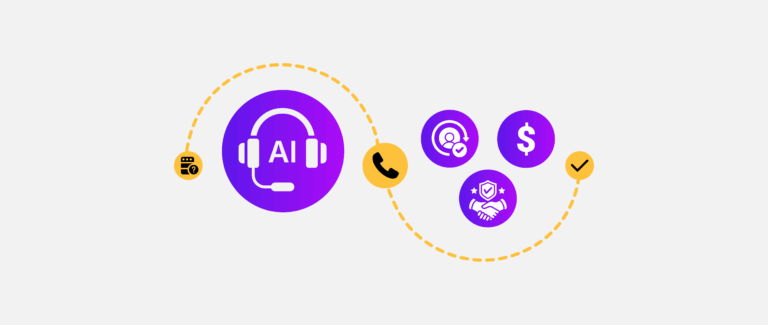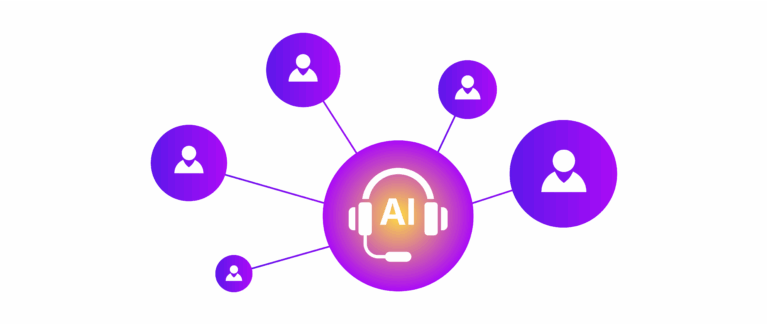What if your best sales rep never slept, never forgot a lead, and never missed a follow-up?
Sounds too good to be true? Only until now.
But first, let’s understand where most deals get stuck. It occurs when there’s a gap between interest and action.
A lead requests a demo… then disappears. A follow-up gets missed. A meeting falls by the wayside. Multiply that across a pipeline, and suddenly, your cycle time looks less like momentum and more like drag.
However, this is changing with voice-first conversational AI platform agents.
Unlike rule-based bots or scripted voicemail trees, these AI agents engage in real, unscripted conversations. They listen, respond, follow up, and take action autonomously.
Let’s explore what voice AI agents are, how they differ from traditional automation tools, and how they help reduce the time it takes to move from first contact to closed deal.
What are conversational or voice AI agents?
Most people hear “voice AI” and picture a friendlier version of a call center bot, or a chatbot that talks.
But that’s not what this is.
Voice AI agents are a different class of technology. They’re built not just to speak, but to converse. To understand. To respond like a real person would in real-time, and in a real context.
These agents are capable of:
- Understanding natural speech patterns, including pauses, accents, hesitation (“um,” “you know”), and incomplete sentences
- Managing turn-taking. They know when a person is speaking, when to wait, and when to respond without interrupting
- Handling interruptions. If a person cuts in mid-sentence, the AI can pause, listen, and then resume the conversation logically
- Responding in real-time with context-aware answers, not canned responses
- Detecting intent even when the wording is vague or indirect
- Adjusting tone and pacing to match the speaker’s energy or urgency
How voice AI agents shorten your sales cycle
Speeding up your sales cycle is all about fixing the roadblocks that slow down deals. It includes long waits between conversations, missed follow-ups, or inefficient qualifications.
Here’s how Voice AI agents tackle these issues:

1. Personalized outreach
Calling thousands of prospects with a generic script wastes time and turns people off. Voice AI agents avoid that by using data your business already has, such as customer profiles, recent company news, and previous interactions, to make each call relevant.
For example, if someone recently submitted a loan application, the AI might say:
“Hi Steve, I’m following up on your loan application to see if you have any questions or need help with the next steps.”
Now, you must know that this personalization does not come out of a script. It is dynamically generated based on the lead’s data and behavior, which makes the conversation feel natural.
Because AI can do this thousands of times a day, your outreach becomes far more effective, increasing the number of quality connections without increasing your team’s workload.
As B2B sales cycles get longer, AI tools for business show greater impact with instant conversations.
2. 24/7 availability
Waiting hours or days for a response kills momentum and interest.
So, what is the solution?
Voice AI agents are available 24/7. They answer questions, book meetings, and handle objections any time of day.
Imagine a lead calling at midnight, from a different location, with a question about pricing or product features. Instead of going to voicemail or waiting until morning, the AI can respond immediately, giving accurate information, or scheduling a call with a human rep for later.
This continuous availability keeps your sales pipeline flowing smoothly, reduces drop-offs, and shows prospects you’re responsive.
3. Smart lead qualification
Chasing unqualified leads is cumbersome.
Voice AI agents ask targeted questions about budget, timeline, and specific needs, and then decide if a lead fits your criteria.
This qualification is not a rigid script. The AI adjusts questions based on responses, and if a lead isn’t a good fit, it politely ends the call or suggests alternative next steps.
This saves your sales reps valuable time, helping them concentrate on serious prospects and accelerate deal closure rates.
When you’re using AI for customer experience, you’re making better decisions, faster.
4. Handling objections with patience and data
Objections like “It’s too expensive” or “I’m not sure this fits our needs” are common, but how you respond determines whether the deal moves forward or stalls.
Voice AI agents listen carefully to objections and respond with proven answers based on data from past successful calls.
For instance, if price is a concern, the AI might say:
“I understand budget is important. Many clients have seen a return on investment within the first quarter. Would you like me to send a budget estimation?
AI calmly guides prospects through their concerns until they’re ready to move on, which keeps the conversation productive and on track.
These kinds of AI-powered solutions keep your prospects engaged and moving forward.
5. Continuous improvement through data and insights
Every call made by a Voice AI agent generates valuable data; which questions prospects ask, where conversations stall, which responses work best, and what objections come up most often.
Your sales leadership can use this data to identify trends and continuously refine your sales strategy. For example, if many prospects hesitate over a particular objection, your team can develop better answers or adjust your messaging proactively.
This amalgamation of analytics and AI makes your sales process smarter over time and aligns your actions with what’s working.
Closing the loop
Voice AI agents are built to take on the repetitive, time-sensitive tasks that slow down your sales process. They respond in real time, work across tools, and adapt based on context.
But the value doesn’t come from the tech alone. It comes from how you apply it.
The teams getting ahead are the ones experimenting early, learning fast, and improving how they work week by week.
Voice AI is already changing how sales gets done.
If you’re exploring AI-powered selling, start by testing Voice AI with your follow-ups.
The results will speak louder than any pitch.





